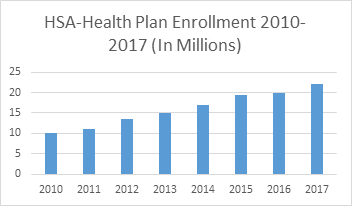
As more employers adopt high-deductible health plans, there has been a steady increase of employees opting to participate in Health Savings Accounts (HSAs). With HSA participation on the rise, it is important to have an understanding of how this plan works and how it could benefit you!
Each year the Internal Revenue Service (IRS) calculates cost of living adjustments and releases the maximum contribution limits for HSAs. For 2019 those adjusted maximum contributions will be $3,500 for a single person and $7,000 for family contributions (currently $3,450 and $6,900 respectively for 2018). With these maximums in mind individuals can decide how much they want to contribute to their HSA.HSAs provide for unique investment and savings opportunities for account holders. There are three ways to get tax benefits from these accounts. First, account holders can make tax-free payroll and non-payroll contributions. To explain further, HSA contributions may be deducted through an employee’s paycheck pre-tax; those deductions go directly into their account. Non-payroll contributions can also be made and are still tax deductible, the tax benefit won’t be seen until taxes are filed at the end of the fiscal year by taking an above-the-line tax deduction. Second, any interest or earnings made on the account are tax-free; allowing account holders to accumulate more funds over time. Third, account holders are able to take tax-free withdrawals at any time for qualified health expenses, additionally, at retirement age, account holders can take tax-free withdrawals at any time for any expense!
Saving for future health expenses is made easy with HSAs, unlike the use-it or lose-it design of an FSA, HSA rules allow an account holder to grow their account over time with no deadline for withdrawals; a key feature many tend to forget. Recent studies show that billions of dollars are wasted each year on unnecessary care and HSA dollars are not exempt from that spending. TIP: because the use-it or lose-it rule does not apply, save your HSA dollars rather than waste them on non-essential expense reimbursements!
Quite possibly the most attractive feature of an HSA is that the employee owns their HSA. If an employee leaves their HSA goes with them throughout their life, and into retirement, and as their health expenses increase they can withdraw their funds, tax-free, and pay for their qualified health expenses.
In the next part of this series we will discuss strategies for maximizing HSA use in your day-to-day life.
Back to Education Articles